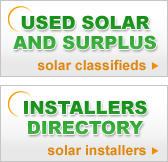What is the solar input of my site?
Look up. Evaluate your patch of blue sky. Is your site unobstructed
by trees, towers, and neighboring homes? If you are free and clear of
shade, you are ready for efficient solar powering.
What are the geographic and climatic factors
affecting my solar system?
Nightly run time product claims are based on specific sunlight conditions.
Outdoor solar lights located in places that receive less sunlight than
potential solar cell intake will operate for fewer hours per night.
Seasonal conditions can also shorten operating times due to insufficient
battery charging. The emitted light weakens when stored battery energy
fades.
Also, consult local codes before installing larger energy systems.
Where will I place my solar panels or solar cells?
After assessing your light availability, choose a space that receives
maximum sunlight to achieve the greatest solar energy input. Aim for
south or southwest exposure. Pay attention to any fences, architectural
overhangs, or trees that may shade your solar cell.
Do I want stand-alone lights, or will I wire
them to an existing solar power system?
If you are using a stand-alone solar
lighting unit, tilt the fixture so that the solar cell (often on
top) faces south. A minor exposure adjustment can make an enormous difference
in lighting output.
At what off-ground height do I want to install
my lights?
Choose ground-level lighting for garden and pathway lighting. Choose
mid-level lighting for door-entries or other 8 to 15ft mounting applications.
Choose high-level lighting, such as solar street lamps and floodlights,
for parking lots and large illumination applications.
How far do you need to cast light?
Check manufacturer product descriptions for estimated light reach.
Solar lighting installation literally
takes seconds!
No troublesome wiring or servicing!
Back to the
Solar Lighting Center

